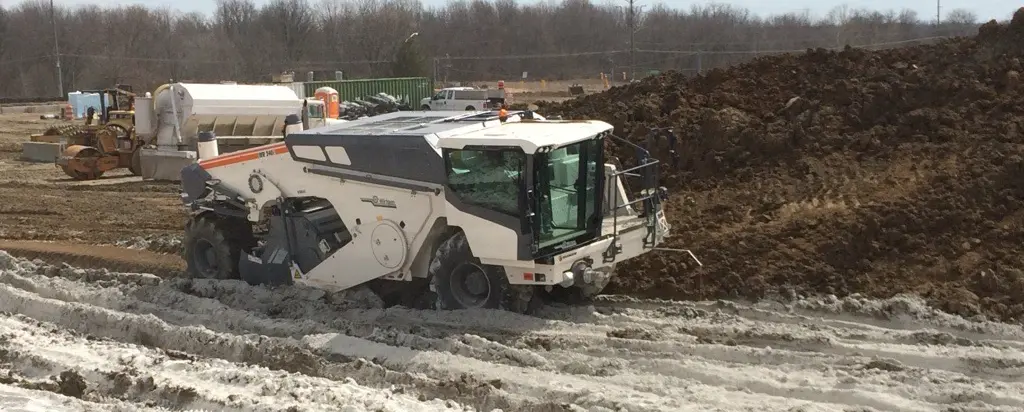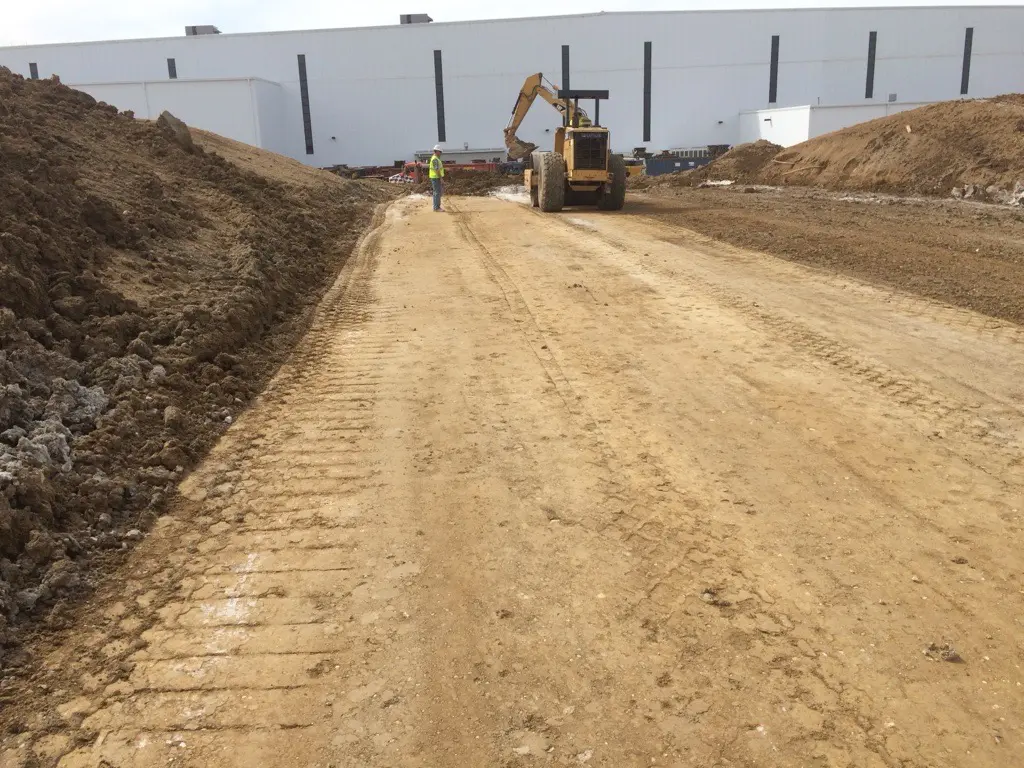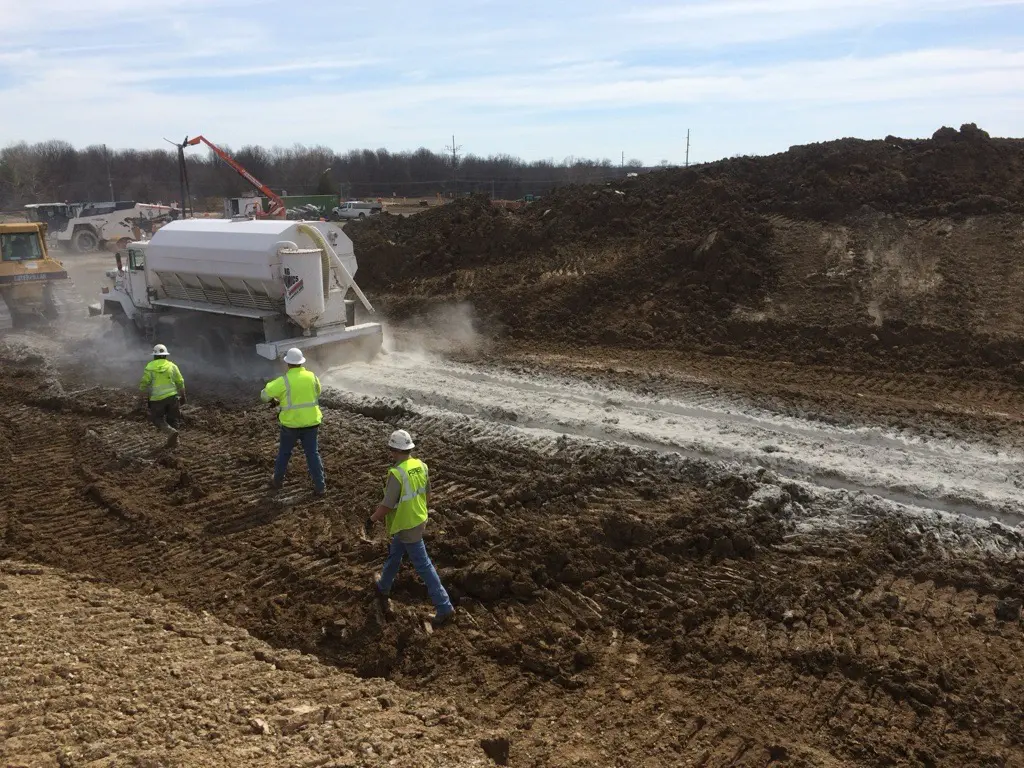Stabilize Soils Using Lime Kiln Dust

Lime kiln dust, often referred to as LKD, can be a valuable option for enhancing soil strength and stability, particularly in medium plasticity index (PI) soils. By incorporating Calciment® LKD into your soil stabilization strategy, you can effectively address issues related to soil performance, ensuring a solid foundation for your construction projects. Discover how Calciment® LKD can help you achieve reliable and durable soil stabilization results.
Get back to work with less downtime.
What is Lime Kiln Dust?
Lime kiln dust is a co-product of the lime manufacturing process that contains a powerful mixture of calcium and magnesium oxides along with pozzolanic materials. Physically, Calciment® LKD is a dry bulk power with similar attributes to quicklime or Portland cement. Its particle size distribution and chemical reactivity make it particularly suitable for waste stream management and soil treatment, including soil stabilization applications.
The chemical composition of lime kiln dust includes:
- High concentrations of reactive oxides
- Calcium oxide (CaO) + Magnesium oxide (MgO)
- Pozzolanic compounds that contribute to stabilizing properties
- Silicon dioxide (SiO2) + Aluminum dioxide (Al2O3)
How is Lime Kiln Dust Formed?
Calciment® LKD comes from the carefully controlled quicklime manufacturing process. It begins with high-quality limestone (calcium carbonate, CaCO3) that undergoes calcination in specialized kilns at temperatures reaching up to 2000°F. During this process, the extreme heat causes the limestone to chemically change into calcium oxide, or quicklime. During the process, small reactive particles of quicklime and pozzolanic components are carried by combustion gases and captured in emission control devices, often referred to as bag houses. LKD, once considered a waste material many years ago, is now understood to be a valuable product for drying, modifying and stabilizing unworkable soils, sediments, sludges and waste.
Quality control measures are integral throughout the production process:
- Continuous monitoring of kiln temperatures
- Regular testing of chemical compositions
- Particle size analysis to ensure consistency
- Strict storage and handling protocols to maintain product integrity
The versatility of Calciment® LKD extends beyond basic soil stabilization, proving valuable in environmental remediation projects and full depth reclamation applications.
The Fundamentals of Soil Stabilization
Every successful construction project builds upon a strong foundation. Soil stabilization helps achieve target strength goals, transforming unsuitable soils into reliable building platforms.
What is Soil Stabilization?
Soil stabilization is the process of altering soil properties to enhance its strength and bearing capacity to improve its performance in construction applications. It goes hand-in-hand with soil drying and modification, other fundamental techniques that address various soil-related issues by modifying the physical and chemical properties of problematic soils. Soil stabilization involves incorporating stabilizing agents that interact with the soil particles to create a more stable material.
Common soil stability issues include:
- Excessive moisture content
- Poor bearing capacity
- High plasticity
- Inadequate strength for construction loads
- Susceptibility to volume changes
- Freeze/thaw cycles expanding soils
Importance of Soil Stabilization in Civil Engineering
In civil engineering projects, proper soil stabilization creates reliable foundations and ensures long-term structural integrity. A chemically stabilized subgrade prevents potential issues from developing into costly problems. This proactive approach improves construction efficiency and minimizes future maintenance needs.
The impact on construction projects manifests in several ways:
- Enhanced structural support for buildings and infrastructure
- Reduced need for virgin material used in remove and replace operations
- Lower risk of future settlement issues
- Reduced construction delays due to poor soil conditions
- Improved workability of difficult soils
- Decreased maintenance costs over the project lifecycle
Modern soil stabilization techniques offer construction teams reliable methods to achieve their project goals while maintaining quality and efficiency. The key lies in selecting the right stabilization approach based on specific soil conditions and project requirements.
The Role of Lime Kiln Dust in Soil Stabilization
The interaction between lime kiln dust and soil can create powerful chemical and physical changes that transform poor soils into stable construction platforms.
How Lime Kiln Dust Improves Soil Properties
When mixed with soil and water, Calciment® LKD can do some impressive things. In overly wet conditions, it quickly reduces soil moisture content through a chemical drying process. Congruently, it also can modify soil-improving engineering properties such as decreasing soil plasticity and shrink-swell potential. Together, these immediately improve soil workability, allowing construction operations to proceed faster. Then, over time, the material continues to react with soil particles, forming strong bonds that create lasting stability.
Key improvements include:
- Rapid moisture reduction in wet soils
- Decreased soil plasticity
- Enhanced soil strength
- Better resistance to inclement weather
- Improved load-bearing capacity
- Reduced volume changes
Suitability in Soil
Calciment® LKD works effectively across various soil types, though its performance can vary based on specific soil characteristics. Professional soil testing helps determine the ideal application rates and methods for specific site conditions, ensuring optimal results for each project’s unique requirements.
Cost Reduction
Eliminates the need for expensive soil removal and replacement, significantly reducing transportation and disposal costs. Calciment® LKD is a cost-effective product that offers a more affordable alternative to both quicklime and Portland cement.
Time Savings
Enables faster construction timelines by quickly improving soil workability and reducing weather-related delays.
Structural Integrity
Reduces swell potential and improves bearing capacity, providing better support for overlying structures.
Long-Term Performance
Creates lasting soil stability through continued chemical reactions, minimizing future maintenance needs.
Resource Conservation
Makes efficient use of existing soils, eliminating the need to import large volumes of replacement materials. Additionally, lime stabilization reduces heavy truck traffic, minimizing impact on roads leading to the project.
Compliance
Helps stabilize sediments and waste streams, meeting landfill requirements like proof-roll and paint filter tests.
DOT Approval
Calciment® LKD is approved for use in numerous State Departments of Transportation.
Implementation Guide
Successful soil stabilization with Calciment® LKD requires proper planning and execution. While the process might seem straightforward, attention to detail throughout implementation ensures optimal results.
Best Practices for Soil Stabilization
Thorough soil testing helps determine the ideal application rate for specific site conditions and proper site preparation sets the foundation for success before beginning any soil stabilization project.
Key steps in the application process:
- Site Assessment: Evaluate soil conditions and identify areas requiring treatment
- Material Planning: Calculate required quantities and establish staging areas
- Application Method: Apply Calciment® LKD uniformly across the treatment area
- Mixing Process: Incorporate the material thoroughly into the soil
- Moisture Control: Add water as needed to achieve optimal mixing results
- Compaction: Complete final compaction within recommended timeframes
- Cure: Like other stabilization techniques, keep construction traffic off of the Calciment® LKD treated soil until sufficient strength has developed. Often a proof-roll can tell if subsequent construction operations can continue.
Equipment and Resources Needed
The right equipment makes a significant difference in achieving uniform soil treatment. Modern spreading and mixing equipment help ensure consistent results while increasing efficiency.
Important equipment includes:
- Spreader Trucks: For uniform material distribution
- Soil Reclaimers: To blend materials thoroughly
- Water Trucks: For moisture control during mixing
- Compaction Equipment: For achieving proper density
- Testing Equipment: To verify treatment effectiveness
Following these implementation guidelines while utilizing appropriate equipment and resources creates the foundation for successful soil stabilization projects that stand the test of time.


Your Partner in Soil Stabilization
For over thirty years, Mintek Resources has led the industry in lime-based soil treatment solutions. Calciment® LKD delivers consistent results across countless stabilization projects. Our extensive distribution network spans 29 states and is supported by multiple DOT approvals that validate our commitment to quality and performance.
Expert Support and Service
Our team of technical experts helps ensure your soil stabilization project succeeds:
- Professional soil testing and consultation for proper material selection
- Support for application rate calculations and mixing recommendations
- Quality control guidance for optimal results
- Responsive customer service from start to finish
With Mintek’s proven experience and dedication to customer success, construction teams can confidently tackle their most challenging soil stabilization projects. Contact our team today to explore how Calciment® LKD can provide the soil stability your project demands.
We're here to help you find the best solution for your next project. Let's get started. Give me a call at 937-641-9901.

Josh Weser
Mintek Resources
Related Posts
Cold Weather Liming for Construction Sites: Everything That You Need to Know
Winter construction doesn't have to mean costly shutdowns. Cold weather liming for construction sites leverages the exothermic reaction of lime-based products to dry, modify, and stabilize soils even in freezing conditions. This comprehensive guide covers the science...
Tariffs Disrupt Construction: Lime Keeps Projects Moving
Tariffs are reshaping the construction landscape. From cement and steel to aluminum and other essential materials, shifting trade policies are creating ripple effects across the industry. Even when prices hold steady, the uncertainty around future costs and sourcing...
Unlocking Pavement Potential: The Long-Term Value of Chemically Stabilized Subgrades
A Foundation in Crisis America’s roadways are the backbone of its economy and daily life, yet they continue to show signs of chronic underinvestment. According to the American Society of Civil Engineers’ 2025 Infrastructure Report Card, the nation’s infrastructure...